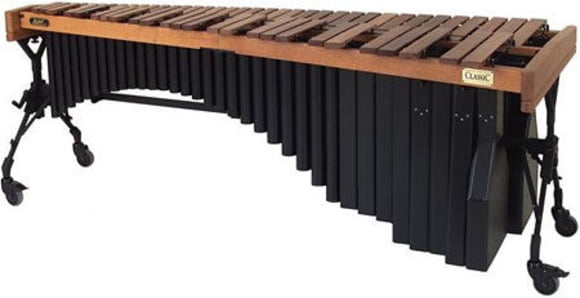3. Marimba
The modern marimba has evolved into a solo instrument, with master percussionists often employing four mallets to play chords and melodic lines simultaneously, and is also a staple of every modern orchestra. The marimba resembles the xylophone and non-percussionists often confuse the two. The marimba usually has longer resonators than the xylophone. The marimbas tonal palette is broader than most other mallet instruments, and is controlled by the hardness of the mallets used. Harder mallets can produce a bright and cutting tone similar to a xylophone while softer mallets can bring out more of the warm and rich resonant timbre inherent to the marimba. Like the xylophone, the marimbas upper and lower bars overlap.

Small portable marimba
The marimba may have a range of 4, 4 1/2, 4 2/3 or 5 octave ranges. As with all mallet instruments, those with wider ranges are more expensive. Most modern solo marimba music requires a 4 2/3 octave instrument (and, increasingly, 5 octaves). Some manufacturers offer extension sets that allow a smaller instrument to be converted into a larger one. However, it is less expensive to select the right instrument from the start.
When choosing an instrument, it is important to consider whether you will have to move it: if so a shorter range can be a sensible choice; transportation poses inherent difficulties. A 5-octave marimba is not only long but also wide, with deep and often bulky resonating tubes. Smaller instruments are somewhat easier to move but unfortunately lack the extra resonance of larger instruments. If a shorter instrument is selected, you may have to rearrange some pitches to suit the instruments range. If the Marimba is to be used as a solo instrument as well as in ensemble work, an instrument with a range of at least 4 2/3 octaves is recommended.

Solo/orchestral marimba
The marimbas bars vary in width, with wider bars used for the lower range and narrower bars used for the upper. The size and width of the bars may also vary slightly from one manufacturer to another, but adapting between instruments isnt difficult. The term xylorimba describes a marimba with identical width bars from the top to the bottom of its range. These instruments are easier to transport because they have a narrower width and shorter resonators but may lack the richness of a traditional Marimba.
Materials
The finest marimba bars are made of wood. Rosewood is the preferred material though padouk is also sometimes used. Rosewood tends to offer longer sustain that padouk and is preferred for its sound, though padouk is less expensive.
Mallets
There is certainly no shortage of mallets available for marimba. Even the handles may be made of a variety of materials since this affects how the mallets feel. Rattan handles flex more than rigid wooden handles. Some mallets have durable synthetic or fibreglass handles for outdoor use in marching bands. Many professionals prefer rattan handles. Either type of handle can break from very strenuous playing. One disadvantage of rattan handles is that they may deform over time, so rattan mallets have to be replaced more often than wooden mallets. Either type can perform well the choice is a matter of personal preference.

Mallets are available in varying degrees of hardness. A Marimba player should have a selection of different mallets for different musical applications. Note that you should never use metal or plastic mallets on a marimba because they are harder than the bars and will damage them. The hardest head appropriate for use on a marimba is the rubber head. This head will give a focused and clear sound with little resonance. Yarn mallets are available in different degrees of hardness; medium and softer ones can produce the warm and resonant sound one often desires from a marimba. Just like with xylophone mallets, the harder the head the more staccato and focused the sound.





